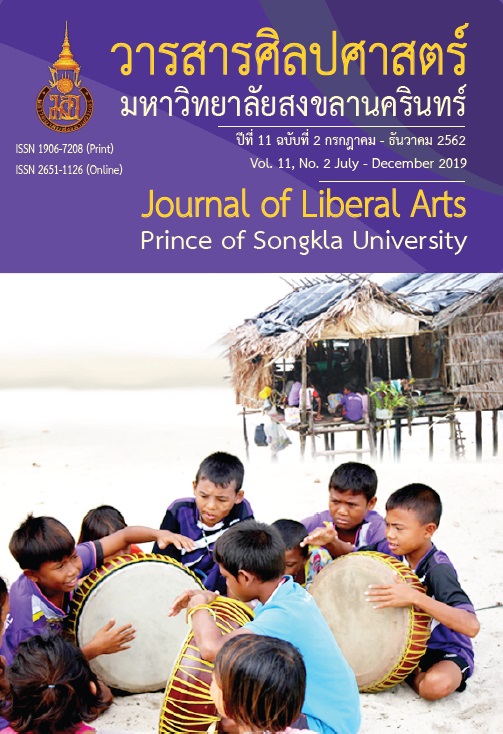Succession of a Ritual Li Mont Display in Pattani: Alterations Resulted from Present Situations
Keywords:
Succession, ritual, Li Mont, PattaniAbstract
The research entitled “Succession of a Ritual Li Mont Display in Pattani: Alterations Resulted from Present Situations” aimed to study ritual practices and cultural inheritance of the show at the present time. The data was collected by observation, interviews and group meetings. The findings were presented using descriptive analysis approach.
Li Mont is performed to cure a family member that has been seriously sick and immedicable. It is an annual performance due to a vital commitment between the Li Mont spirit and its successor and to make a vow to the Li Mont ancestor for the better life of having luck and success.
There are 5 members and 5 musical instruments in a Li Mont troupe. The show takes 3 days and 2 nights which is normally held in the 6th, 7th, 9th and 11th months by lunar system. The ceremony of the show are in order of Kao-rong, Phum-rong, Krab-krue, Wienwai, Berg-rong, Gard-rong, Tang-borimad, Invitation of the Li Mont spirits, Om-num dancing, Ancestor showering, Tee-ma-young, Mrab offering to the ancestor, and taking the ancestor’s leave.
To inherit the Li Mont show, not everyone can do but only for the heir with the same bloodline to the Li Mont ancestor called “same grandparents”. The practices have been inherited since the age of an ancestor and will be continued by their generations. This is as to be grateful to the ancestor and representative of worship. Besides, the performance provides a number of advantages to family members, particularly building strength and unity. Also, it is a great chance for family gathering to discuss their problems and share both their sadness and happiness, and hence mental treatment of family members as they do believe that the Li Mont spirits are behind their success and are guarding, supporting and blessing them in every day of lives.
References
Chumpengpan, P. (2005), Southern culture, Bangkok: Suriyasan.
Jittam, P. and Pongpaiboon, S. (1999), Limont encyclopeddia of Thai culture, Southern 6, p. 2828, Bangkok: Amarin Printing. [In Thai]
Kaewphim, C. (2011, 21 July). Personal Interview. [In Thai]
Noonin, N. (2003), Belief, health and folk wisdom, memorail arts and cultures, University affairs. 5th, Nakornsrithammarat: Walailak university. [In Thai]
Noothong, U (1999), Encyclopedia of Thai Culture, Southern: 1, p 370, Bangkok: Amarin Printing. [In Thai]
Patkaew, C. (1997), “Nora today and in the future” contributed articles on culture and traditional custom of Southern Thailand Teetadwatthanatam, Bangkok: Amarin printing. [In Thai]
Puthyod, N. (2011, 4 June) Personal Interview. [In Thai]
Santasombat, Y. (1989), Human and Culture. Bangkok: Thammasat University. [In Thai]
Wansiri, N. (2007), Social and cultural anthropology, Bangkok: Tanapress. [In Thai]
Downloads
Published
How to Cite
Issue
Section
License
The authors retain the copyright to their article but the Journal of Liberal Arts, Prince of Songkla University reserves the exclusive rights to first publication.






